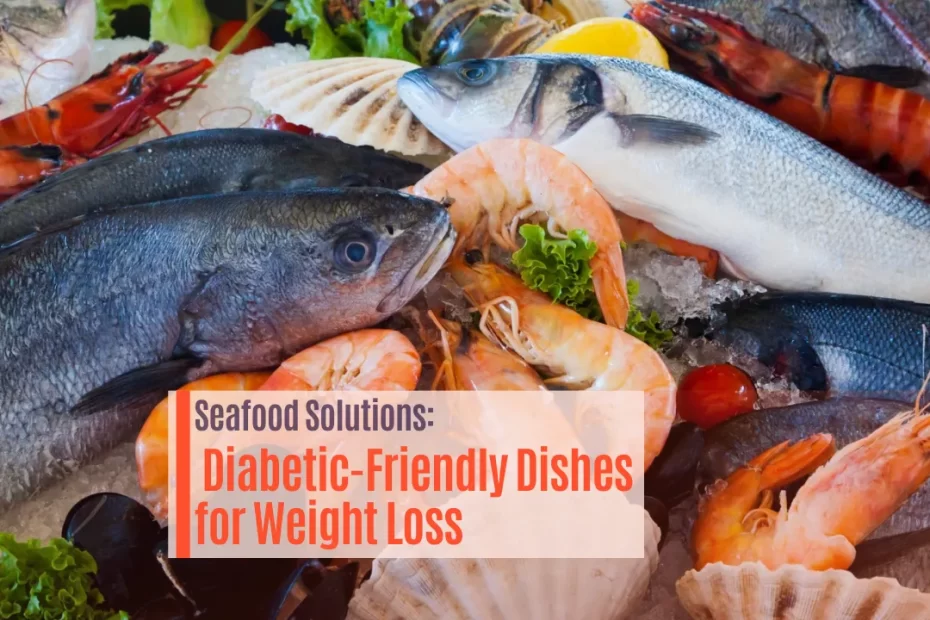Diabetic-Friendly SeaFood: Are you struggling to lose weight while managing your diabetes? Finding a balance between controlling your blood sugar levels and shedding those extra pounds can be challenging. But don’t worry; with the right approach, you can transform your diabetic food plan to support your weight loss goals.
By making strategic changes to your diet and meal planning, you can achieve success in both managing your diabetes and losing weight. With a few simple tweaks and guidance, you can make your food choices work for you rather than against you.
Eight Delicious and Diabetic-Friendly Seafood Options for Weight Loss
Including diabetic-friendly seafood in your diet can support blood sugar control, provide essential nutrients, and promote weight loss. Here are eight healthy diabetic-friendly dishes you can enjoy:
| Seafood Option | Key Benefits for Diabetes & Weight Loss | Best Cooking Methods |
|---|---|---|
| Salmon | Rich in omega-3 fatty acids that reduce inflammation and improve insulin sensitivity. Excellent protein source to stabilize blood sugar levels. | Grilled, baked, or added to salads. |
| Sardines | High in omega-3s, low in mercury, packed with protein and calcium. Budget-friendly and sustainable choice for diabetic-friendly dishes. | Enjoyed canned, in salads, or spreads. |
| Mackerel | Oily fish with omega-3s and vitamin D. Supports immune and bone health while improving insulin response. | Grilled or smoked. |
| Shrimp | Low in calories and carbs, high in protein and selenium with antioxidant properties. Perfect for seafood for weight loss. | Stir-fries, salads, or grilled skewers. |
| Tilapia | Low-fat, low-calorie white fish rich in protein, vitamin B12, and selenium. Supports overall metabolic health. | Baked, grilled, or seasoned with herbs and spices. |
| Trout | Excellent protein and omega-3 source. Lower in mercury, supporting heart and blood sugar management. | Baked, grilled, or pan-seared. |
| Cod | Lean, mild white fish, low in calories and carbs. Provides vitamin B12 and selenium, making it a great diabetic-friendly seafood option. | Fish tacos, baked fillets, soups, or stews. |
| Clams | Nutrient-dense, low-calorie seafood high in protein, iron, and vitamin B12. A great addition to a diabetic diet. | Steamed, in pasta, soups, or stews. |
🐟 Preparing Seafood for Diabetes Management
✅ Best Cooking Methods
- Grilling, Baking, or Steaming
These methods preserve nutrients and avoid excess fats. Grilled salmon, baked cod, or steamed shrimp are excellent choices. - Poaching
Cooking fish gently in water, broth, or herbal infusions helps keep it moist without adding extra calories. - Air-Frying
Provides a crispy texture similar to frying but with significantly less oil.
⚠️ Methods to Limit or Avoid
- Deep-frying: This method adds unnecessary saturated fat and calories, which may increase blood sugar levels.
- Creamy Sauces or Heavy Batters: Often contain added sugars, refined carbohydrates, or unhealthy fats that can spike blood glucose levels.
🌿 Smart Flavoring Options
- Use Herbs and spices like garlic, dill, parsley, turmeric, and ginger to enhance flavor while also offering anti-inflammatory benefits.
- Fresh Citrus: Lemon or lime brightens seafood dishes without adding sugar or calories.
- Healthy Oils: A drizzle of extra virgin olive oil is diabetes-friendly and heart-healthy.
🥗 Balanced Pairings
Pair seafood with non-starchy vegetables (broccoli, spinach, zucchini, peppers) for fiber and steady glucose control.
Add a side of whole grains (quinoa, brown rice, barley) for slow-digesting carbohydrates.
Avoid pairing with fried sides, white bread, or sauces that are high in sugar.
🍴 Portion Control
A diabetes-friendly serving is typically 3–4 ounces of cooked fish (about the size of a deck of cards).
Aim for 2–3 servings of fatty fish per week, such as salmon, mackerel, or sardines, to reap the benefits of omega-3s.
💡 Example Diabetes-Friendly Seafood Meals
- Baked Salmon with Steamed Broccoli & Quinoa
- Grilled Shrimp with Zucchini Noodles & Olive Oil Drizzle
- Poached Cod with Lemon & Garlic over Brown Rice
- Air-Fried Tilapia with Roasted Vegetables
👉 By focusing on light cooking methods, smart seasoning, and balanced sides, you can enjoy seafood that supports blood sugar management, heart health, and overall wellness.
Role of Omega-3 Fatty Acids and Other Nutrients:
Omega-3 fatty acids found in seafood have anti-inflammatory properties that can help reduce the risk of heart disease, a common complication in diabetes. They also support brain health and may positively impact insulin sensitivity. Seafood is also a good source of vitamin D, a nutrient essential for maintaining bone health.
Practical Tips for Incorporating Seafood (Diabetic-Friendly Dishes):
- Grill, Bake, or Steam: To retain seafood’s nutritional value, opt for cooking methods like grilling, baking, or steaming. Avoid deep-frying, as it can add unnecessary calories and carbohydrates.
- Serve with Veggies: For a balanced meal, complement your seafood with non-starchy vegetables like broccoli, spinach, or asparagus.
- Choose Quality Sources: To minimize the risk of contaminants, select high-quality, fresh, or frozen seafood from reputable sources.
- Variety is Key: Include a variety of seafood in your diet to enjoy a wide range of nutrients. Try different types and recipes to keep meals exciting.
Comparison of Seafood Options: Fish, such as salmon and mackerel, are higher in omega-3 fatty acids than most shellfish. However, shellfish like shrimp and crab are lower in calories and fat. Both types have unique benefits, so including a mix of fish and shellfish in your diet is beneficial.
Cooking Methods and Glycemic Index: Grilling, baking, and steaming are diabetes-friendly cooking methods, as they don’t add extra carbohydrates or unhealthy fats. These methods also help maintain seafood’s low glycemic index.
Contaminants and Safe Choices: To minimize the risk of pollutants, consult your region’s seafood advisories. In general, smaller fish, such as sardines and trout, have lower mercury levels.
Benefits for Cardiovascular Health: Regular seafood consumption can help improve lipid profiles, lower blood pressure, and reduce the risk of cardiovascular diseases, which are common complications of diabetes.
Allergies or Sensitivities: For individuals with seafood allergies or sensitivities, consider alternative sources of omega-3 fatty acids, such as flaxseeds, chia seeds, or omega-3 supplements, as a suitable alternative. Always consult a healthcare provider for personalized recommendations.
Incorporating seafood into a diabetic-friendly diet offers numerous health benefits.
Tips for Preparing Diabetic-Friendly Seafood Meals
When creating Diabetic-Friendly Seafood dishes, focus on cooking methods that preserve nutrients and avoid excess fat—grilling, baking, or steaming are excellent choices over frying. These approaches help reduce unnecessary calories while maintaining flavor and texture.
- Be cautious with sauces and marinades; opt for those without added sugars or high calories. Instead, enhance taste with lemon juice, fresh herbs, garlic, or a drizzle of heart-healthy olive oil.
Incorporating these Diabetic-Friendly Seafood meals into your routine supports balanced blood sugar levels, delivers essential omega-3 fatty acids, and promotes heart health. Regularly enjoying Diabetic-Friendly Seafood is a smart step toward a nutritious, sustainable, and diabetes-friendly lifestyle, providing critical nutrients, controlling blood sugar levels, and promoting a balanced diet.
Share this:
- Click to share on Facebook (Opens in new window) Facebook
- Click to share on Pinterest (Opens in new window) Pinterest
- Click to share on LinkedIn (Opens in new window) LinkedIn
- Click to share on X (Opens in new window) X
- Click to share on Tumblr (Opens in new window) Tumblr
- Click to share on Bluesky (Opens in new window) Bluesky

